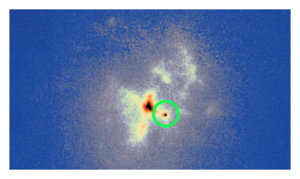The galaxy Cygnus A "shines" in radio frequencies (seen
here), coming from relativistic electrons zipping along
jets shot out from the central black hole and deposited in
giant "radio lobes." (The lobes extend outward roughly
10 times farther than the galaxy itself, which is invisible
in this image.) NRAO / AUI
here), coming from relativistic electrons zipping along
jets shot out from the central black hole and deposited in
giant "radio lobes." (The lobes extend outward roughly
10 times farther than the galaxy itself, which is invisible
in this image.) NRAO / AUI
Camille M. Carlisle wrote:
Last week at the American Astronomical Society meeting in Grapevine, Texas, astronomers made an announcement that’s caught the interest of several researchers: a very bright something has appeared in a well-known galaxy.
That galaxy is the elliptical Cygnus A. Cygnus A is one of the brightest radio sources in the sky. It lies approximately 800 million light-years from us (redshift of 0.056). In its core sits a supermassive black hole madly eating and cocooned in gas, while two jets shoot out to either side and light up the intergalactic medium. This activity produces the radio radiation that makes Cygnus A so bright.
Using the recently upgraded Karl G. Jansky Very Large Array (VLA) in New Mexico, Rick Perley (NRAO) and colleagues took a gander at Cygnus A — the first time the instrument has looked at the galaxy since 1989.
...
The new observations showed a surprise: a new, secondary object just southwest of the central black hole. This object wasn’t in the 1989 radio image. Additional, higher-resolution observations with the Very Long Baseline Array also picked up the object, clearly distinct from the galaxy’s nucleus. It’s roughly 1,300 light-years from the center.
This false-color infrared image from the Keck II
telescope shows the galaxy Cygnus A. Its central
supermassive black hole is the large red-black splotch,
but this 2003 image reveals a second, mystery source
(circled) nearby.
G. Canalizo et al. / Astrophysical Journal 2003
telescope shows the galaxy Cygnus A. Its central
supermassive black hole is the large red-black splotch,
but this 2003 image reveals a second, mystery source
(circled) nearby.
G. Canalizo et al. / Astrophysical Journal 2003
AnnThe team determined that the whatchamacallit wasn’t a foreground object in the Milky Way, nor a cluster of young stars in Cygnus A. Rather, it seemed to be a compact cluster of old, red stars, with all the trappings of being the stripped-down core of a much smaller galaxy that Cygnus A had eaten. That minor merger might also explain why the big galaxy’s black hole has “turned on,” the astronomers suggested in their 2003 Astrophysical Journal paper.
